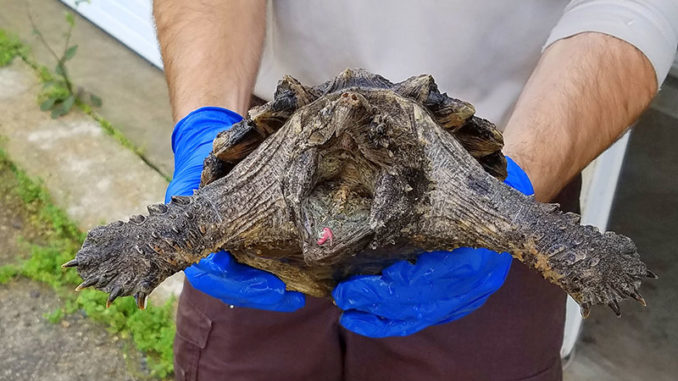
Alligator snapping turtles are the largest freshwater turtle in North America and can be found throughout the southern states, including all over Louisiana. They get their name from their powerful jaws and the noticeable ridge running down the shell that resembles an alligator’s back.
Snapping turtles are an apex predator and are important because they help to keep fish populations under control and clean the environment by eating decaying animals.
Unfortunately, overharvesting and habitat destruction has caused the U.S. Fish & Wildlife Service to propose placing the alligator snapping turtle on the threatened species list.
Brett Hortman is the manager of the U.S. Fish & Wildlife Service’s National Fish Hatchery in Natchitoches, and he and his staff are working to keep the snapping turtle population healthy.
Hortman believes that the Fish & Wildlife Service will, indeed, place the turtle on the threatened species list because of overharvesting.
“Louisiana is one of only two states where you can take them with a basic fishing license,” he said. “If they are put on the threatened species list, it will end fishing for them except for some provisions for what’s called ‘incidental’ bycatch by commercial fishermen.”
Living a century
Amazingly, the alligator snapping turtle can live to be one hundred years old and weigh up to two hundred pounds.
“In 10 to 12 years, they reach maturity at about 50 pounds and will gain about one pound per year after that,” Hortman said. “So, you can judge their age by how much they weigh.”
Because of its longevity, overharvesting affects the snapping turtle population more than other animals.
“Considering that they live for so long,” Hortman said, “if you take out one mature turtle you actually lose several generations.”
To help the turtles, the Natchitoches National Fish Hatchery has launched the Head Start Program in partnership with the University of Louisiana at Monroe (ULM) and the Black Bayou Lake National Wildlife Refuge, which is located near Monroe.
Emmet Guy is a fisheries biologist at the fish hatchery who is involved in the Head Start Program. He explains that ULM students collect and incubate the eggs from Black Bayou, and the fish hatchery raises the hatchlings for two years. The turtles are then released back into the lake or other approved nearby areas.
Summer all the time
The fish hatchery uses some innovative techniques to grow the turtles rapidly. Guy said that because snapping turtles grow fastest during the hot summer, “We control their environment by maintaining a temperature around 80 degrees and a 12-hour daylight cycle and make them think it’s summer all the time. It makes them really grow fast.”
Sometimes the biologists have to think outside the box to help the turtles thrive. Guy recalls noticing that some of the juvenile turtles were not eating as they should. Knowing that they like to use cover when feeding, the staff modified the holding tanks by using PVC pipes to simulate floating vegetation.
“The turtles moved right under it and took off eating,” Guy said.
Because the turtles have constant access to feed, no predators and warm water temperatures, the two-year-old turtles that are released back into the lake are the same size as a five-year-old in the wild.
“This size vastly increases their odds of reaching reproductive maturity,” according to Hortman.